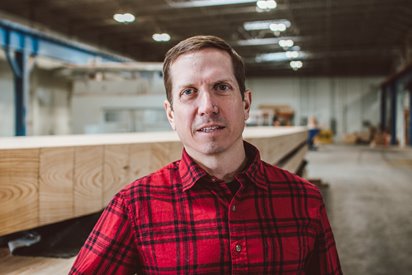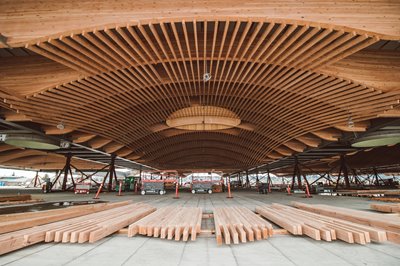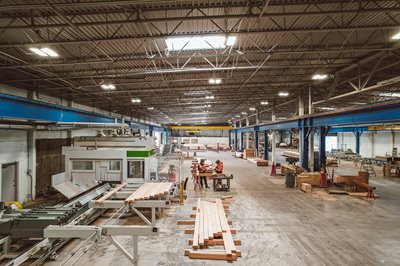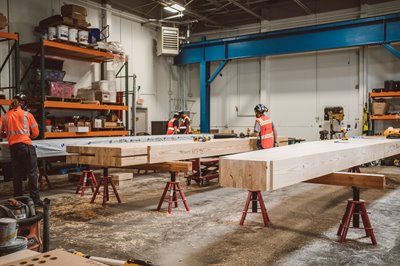
Component Alliance: Welcome Chris, we are so thrilled to hear about Timberlab! As mentioned above Timberlab fabricates mass timber components - can you elaborate a little more on the mass timber products that you produce?
Chris: Our team is focused on expanding the mass timber supply chain, so in both the Pacific Northwest and the Southeast, we are focused on complementing the regional manufacturing capacity, producing engineered wood products such as glulam beams and columns, cross laminated timber (CLT), and Mass Plywood Panels (MPP). Timberlab provides value-add services for these products by transforming these building products into building components, like a glulam beam cut and prepared with hardware, to facilitate quick installation on site. We have a full team of structural engineers, detailers, and construction professionals to support our fabrication process. We have one facility in Portland, Oregon, and a new facility opening in January of 2023 in Greenville, South Carolina.

Component Alliance: As most can see by the images these engineered wood products make for beautiful architecture. Can you tell us about a project, or you that you have completed?
Chris: Here in our hometown, Portland, OR, the PDX airport is undergoing a massive redevelopment of its main terminal. The new structure is a 9-acre undulating roof featuring one of the most brilliant displays of mass timber in the country. Timberlab (formerly Swinerton Mass Timber) was very involved in this project and provided fabrication services on many elements of this extraordinary roof structure. It's a wonderful example of local procurement and the stunning architectural capabilities of mass timber.
Another project that we are immensely proud of is the Heartwood project in Seattle, Washington Heartwood is an 8-story residential structure with a fully exposed mass timber frame. Heartwood is the first Type IV-C building permitted under the new Type IV heavy timber code provisions in Washington state. This two-hour rated structural frame utilizes CNC joinery to maintain a two-hour rating at column, beam, and floor connections.
Component Alliance: How do you feel mass timber production is similar to truss and wall panel production? In your mind are there any major differences?
Chris: All prefabricated construction products share the same goals of compressing construction schedules, improving quality and safety outcomes, and minimizing waste. Our holistic mass timber systems are designed as a “kit-of-parts” package produced entirely off-site and assembled quickly and quietly in the field. The precision that goes into the design and fabrication process allows for a highly predictable and efficient installation process, as each component is shaped to 1/16-inch tolerances and equipped with all connection hardware.
The major difference with a mass timber frame is that mass timber elements are being used in large commercial buildings that would normally be built with concrete or steel. A decent number of the buildings using mass timber are rated to 1 or 2 hours. The mass timber frame is competing with the structural performance of concrete and steel and provides equivalent or better fire protection than concrete and/or steel frames.

Component Alliance: Mass Timber has a stronger concentration in the Northwestern portion of the United States and are traditionally made with species cultivated in BC and western U.S. However there has been some advancements and several including Timberlab are working toward producing these products with Southern Yellow Pine can you give us an update on this process?
Chris: The Southeast United States has an abundance of sustainably managed Southern Yellow Pine (SYP) forest land. The SE contains the largest capacity of wood fiber in North America, and there are several glulam and CLT manufacturers as well. That said, like the PNW, fabrication capacity is limited and so we are hoping to take a similar approach to what we did in Portland and provide CNC fabrication services to help connect manufacturers to mass timber projects. We are currently delivering a canopy structure to Tom Lee Park in Memphis, TN, that utilizes SYP, and excited to do a lot more work in this region, celebrating the surrounding trees.
Commercial construction prices on the West coast are generally higher than in the Southeast commercial market. Higher wages, higher costs of onsite labor, higher costs of living, all contribute to higher construction costs on the West coast when compared to the Southeast commercial market. This has created a region that is primed to accept a product, prefabricated mass timber, that can be installed on site in a quicker fashion. The savings of time creates a savings with onsite costs for construction, meaning that mass timber is a suitable and cost-efficient substitution of the traditional steel and concrete construction. Over the past two years, construction costs for concrete and steel have risen nationally, and the gap of costs in construction in the Southeast market has narrowed to make the use of mass timber in these markets more feasible.
New manufacturers have come online in the Southeast market, providing regionally sourced materials for cost effective prices and lower freight costs than shipping material from the West coast manufacturers. The addition of manufacturing capacity is making the use of mass timber with Southern Yellow Pine (SYP) more achievable. Timberlab has added CNC fabrication capacity in the Southeast as this market has a great timber basket and will continue to have strong growth in the construction markets for the forseeable future.

Component Alliance: It seems that Timberlab is planning to bring Mass Timber to the Southern part of the U.S. What market segment do you feel these products will gain initial attraction?
Chris: One of the exciting things about being in this space is the ever evolving and growing utilization of mass timber construction across the market. From office, residential, education, civic, and even industrial applications, mass timber is happening. Specifically in the Southern US, we see residential, civic, and build-to-suit office as the primary markets for mass timber use. CLT in residential applications can greatly increase the speed of construction. New code adoption for the 2024. IBC allows for 12 story structures to be fully exposed timber, opening the door for high-rise residential, office, and mixed-use projects (up to 180 feet). Public and civic projects have a high potential for use with mass timber frames. Build-to-suit projects.
Component Alliance: As this market continues to grow do you feel there could be markets where lumber suppliers sell to mass timber fabricators?
Chris: Specifically, in the Southern Yellow Pine market, there is a lack of KD15 dimensional product available through the lumber market. The key to engineered mass timber products is having superior quality, low wane, dried lumber available for conversion to CLT or Glulam. Lumber suppliers who focus on creating value added products will have a market for the sale of drier material, sorted, stacked, and prepared for mass timber producers. The key is to have dried material that has less than a 15% moisture content.

Component Alliance: Thank you so much for your time and wisdom, this is a fascinating segment of the building material industry! Is there anything else you'd like to share with us about this fascinating emerging industry?
Chris: Mass timber is attractive as a building material because of three factors: Sustainability, Aesthetics, and Speed of Construction. It is not always the lowest cost option, but it is the higher value option for project owners to consider as a competitive advantage for their project, and, over time, mass timber will become more cost effective. As more companies fill in the supply chain for mass timber, the cost of mass timber will continue to get better when compared to the mature supply chains of concrete and steel. This market sector is growing quickly and has a lot of interest both domestically and internationally. The industry is close-knit and collaborative with many companies working together on seismic research, fire research, and product development.
